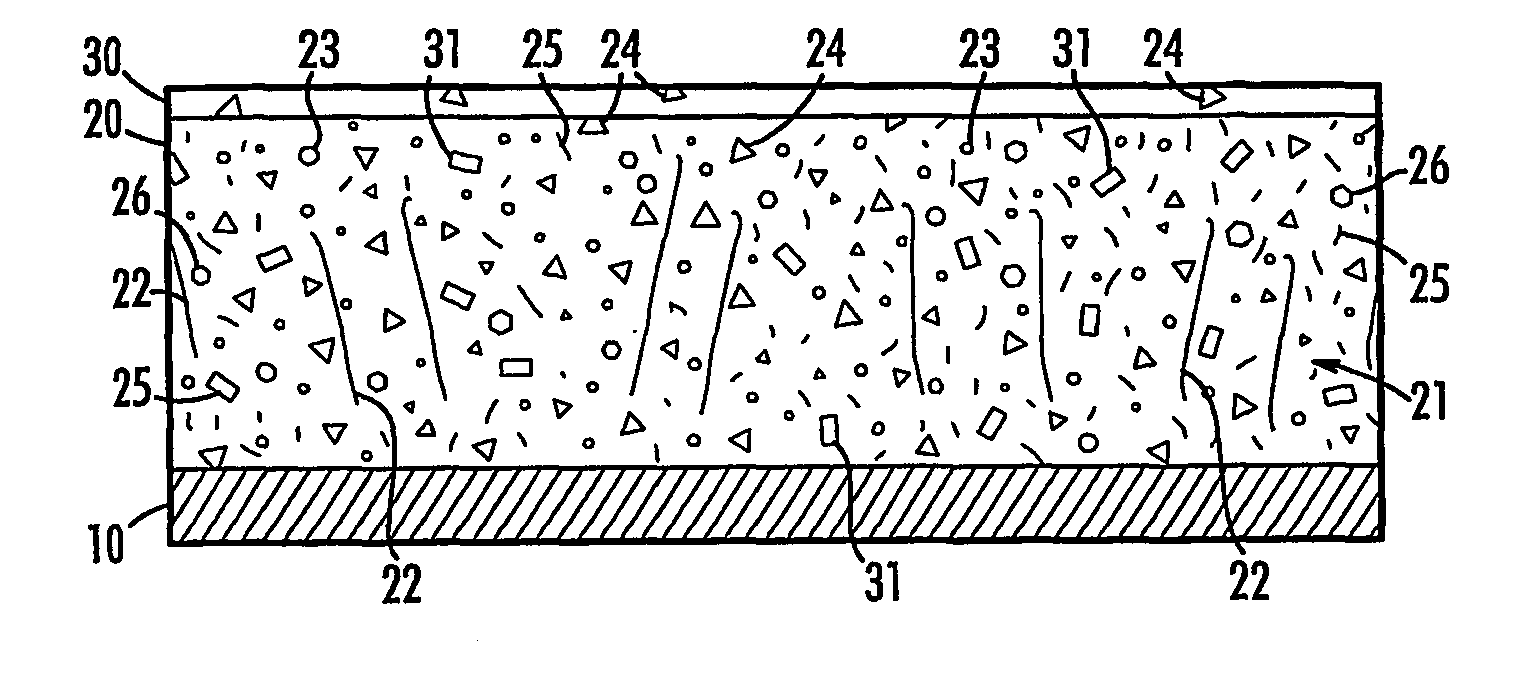Thick radiation sensitive devices
a radiation sensitive device and thin coating technology, applied in the direction of thin material processing, electric discharge tubes, dosimeters, etc., can solve the problems of multi-step and expensive process, the thickness of the coating is usually limited to less than about b>30/b> microns, and it is not practical to make such a thick coating from a solution or emulsion
- Summary
- Abstract
- Description
- Claims
- Application Information
AI Technical Summary
Benefits of technology
Problems solved by technology
Method used
Image
Examples
example 1
A pH Dye as Indicator, a Halo Compound as Activator and Use of Two Reactants to Make the Binder
[0156] The system comprises: [0157] Binder: Poly(propylene glycol), MW 1000 and poly(isophorone diisocyanate) [0158] MW 1550 (MW=average molecular weight). [0159] Activator: Trichloroethane [0160] Indicator: Leuco malachite green [0161] Catalyst: A tin compound, (Metacure T-9 of Air Products, Allentown, Pa.)
Procedure: 15 g of the poly(propylene glycol) with a MW of about 1000 was mixed with a leuco malachite green solution comprising about 3 grams of dye in trichloroethane. To the mixture were added 10 g of poly(isophorone diisocyanate) MW 1550 and 10 drops of the catalyst followed by mixing. The mixture became solid in about ten minutes. When irradiated with 50 Gy of 100 KVP X-ray the mixture turned light green.
example 2
pH Sensitive Dyes as Indicators, Halocarbons as Activators and Binder from Monomer and Polymer Mixture
[0162] The system comprises: [0163] Binder: HH772 Acrylic Casting and Embedding Kit (Polysciences, Warrington, Pa. 18976) [0164] Indicator: Leuco malachite green [0165] Activator: Trichloroethane (TCE)
Procedure: One gram of leuco malachite green was dissolved in 20 g of HH772 casting and embedding kit which was a mixture 30% polymethylmethacrylate dissolved in 70% methylmethacrylate monomer. To the mixture was added 1.2 g of 5% benzoyl peroxide in dibutyl phthalate, 5 ml of trichloroethane and 2 drops of a promotor (N,N-dimethyl toluidine) followed by mixing. The mixture was very faint green and became solid in about 10 minutes at RT. The sample was irradiated with 50 Gy of 100 KVP X-ray. The irradiated portion turned green.
[0166] A large number of dyes listed in table 1 and some reduced dyes were also evaluated. Many dyes changed or developed colors, e.g., acid sensitive dyes s...
example 3
Use of Liquid Diacetylene as an Indicator and Two Reactants to Make the Binder
[0169] The system comprises: [0170] Binder: Poly(ethylene glycol) MW 400 and 1,6-hexamethylene diisocyanate (Bayer Corp., Pittsburgh, Pa.) [0171] Indicator: Methyltricosa-10,12-diynoate (TCME), mp 18-19° C. [0172] Catalyst: Triethylamine
Procedure: A mixture of 30.5 g of poly(ethylene glycol) and 15.5 g 1,6-hexamethylene diisocyanate was prepared in a jar. To the mixture was added while stirring 1.5 g triethylamine and 4.5 g TCME. The mixture was heated slowly at 70° C. and then cool to room temperature. The mixture became transparent solid within 30 minutes. The solid became opaque in a refrigerator (˜7° C.) and in a freezer (˜20° C.). The sample was irradiated with 5 Gy of 100 KVP X-ray on an ice block. The irradiated portion turned blue. Upon bring to RT, the sample became clear and the irradiated portion changed to red.
[0173] A silicon polymeric block made by mixing SC-102 Hardener of Lord Chemical ...
PUM
 Login to View More
Login to View More Abstract
Description
Claims
Application Information
 Login to View More
Login to View More - R&D
- Intellectual Property
- Life Sciences
- Materials
- Tech Scout
- Unparalleled Data Quality
- Higher Quality Content
- 60% Fewer Hallucinations
Browse by: Latest US Patents, China's latest patents, Technical Efficacy Thesaurus, Application Domain, Technology Topic, Popular Technical Reports.
© 2025 PatSnap. All rights reserved.Legal|Privacy policy|Modern Slavery Act Transparency Statement|Sitemap|About US| Contact US: help@patsnap.com



